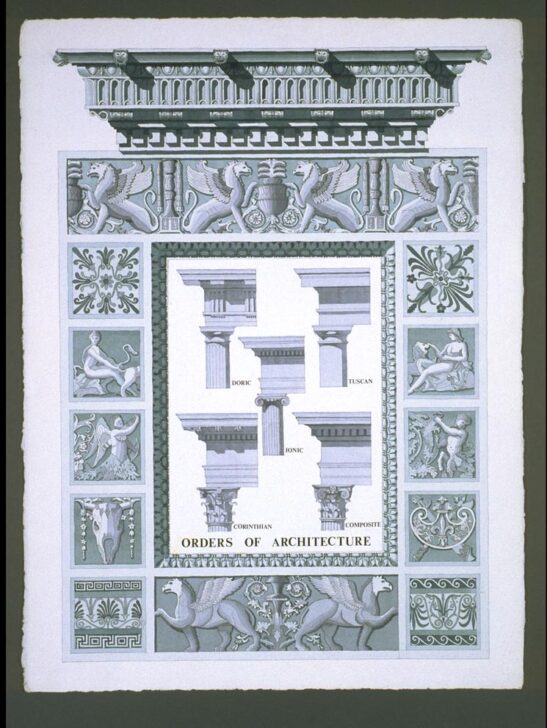The Five Orders of Architecture
Herbert W. Johe

Description
Relevant information pertaining to the five Orders of Architecture follows:
DORIC: Named after the Dorian Greeks who occupied the mainland of Greece and its colonies, it is the earliest Order in Greek architecture. The design of the entablature, especially the use of Triglyphs (blocks with vertical channels) reflects its probable evolvement from timber prototypes. Signifying sturdiness and dignity, the architectural proportions of the Order were supposedly derived from the proportion of man. Columns almost always have a shallow fluting and no base, resting directly on the stylobate. The design of the pediment frequently provided a setting for sculpture, an important supplement to Greek building, especially temples.
TUSCAN: A simplified version of the Doric Order, it was developed by the Romans and never used by the Greeks. With an unfluted shaft resting on a base, capped by a simply moulded capital, its use was limited to the early years of the Roman republic. Frequently used in mausoleum design, its utter simplicty created an atmosphere of somberness.
IONIC: Supposedly manifesting an Asiatic (Persia, Assyria and Asia Minor) origin, the most distinctive and conspicuous features of the Order lie in a) the slender fluted columns, which according to Vitruvius expressed femininity, and b) the Volultes (scrolls or spirals) and Ovola (convex moulding of egg and dart, or egg and tongue) in the capital. Important examples of the Order are the north porch of the Erechtheum and the Niké Apertos (Athena Niké) which stands on the Athens Acropolis.
CORINTHIAN: Named after the city of Corinth, Greece, it is the third Order of Greek architecture. It was the favorite Order of the Romans because its ornateness expressed their national love of power and grandeur. Three distinguishing characteristics of the Order are a) a tall bell shaped capital, b) a series of Modillions (small brackets that support the cornice), and c) general richness of detail, enhanced by the use of the Acantus leaf in both the capital and Modillions. The order was little used by the Greeks.
COMPOSITE: Invented by the Romans and similar to the Corinthian order, but heavier, with fewer and larger details. The major change is the capital, which consists of the upper part of the Ionic capital and the lower part of the Corinthian capital. It is the wholly Roman order and was used on triumphal arches, monuments and baths. The name Composite was not created until the Renaissance.
I am much indebted to Nathan T. Whitman, Professor Emeritus of History of Art, University of Michigan, for serviceable criticism and suggestions while preparing this text.
Herbert W. Johe
Usage Rights:
If you are interested in using an image for a publication, please visit https://umma.umich.edu/request-image/ for more information and to fill out the online Image Rights and Reproductions Request Form.